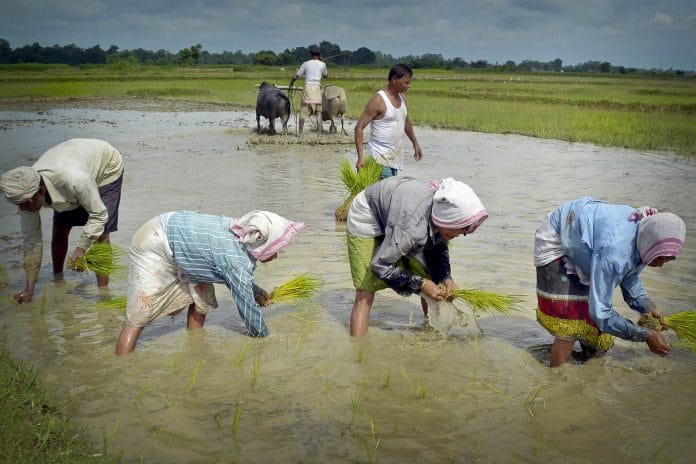New Delhi: Paddy transplantation has begun in Punjab amid a labour shortage. With the lockdown enforced in March triggering an exodus of migrant labourers to their home states, farmers in Punjab are now relying on the local workforce.
The transplantation of paddy traditionally begins on 20 June and lasts for about 20 days. But the state government this year advanced the date by 10 days to 10 June, giving farmers more time to hire workers.
“The paddy transplantation for the kharif season will be accomplished in the state with the help of local labour,” Punjab Agriculture Secretary Kahan Singh Pannu told ThePrint. “Earlier, paddy farmers in the state used to get migrant labourers’ expertise in paddy sowing, but these workers are no more readily available after Covid lockdown because most have left for their homes.”
According to Pannu, almost 10 lakh migrant labourers worked in Punjab during the usual paddy-sowing season but the state only has a lakh of them left.
Pannu also said many farmers have this year diversified to cotton from the water-guzzling paddy. He said the area under cotton crop has seen a record increase this year at 4.90 lakh hectares (LHA) as of 12 June — from 4.45 LHA in 2013 and 3.92 LHA last year.
Also read: Indian-American soil scientist Dr Rattan Lal wins World Food Prize — ‘Nobel’ of agriculture
Labour costs have doubled: Farmers
Paddy farmers in the state say local workers demand higher wages than those who come from states like Bihar and UP, as a result of which labour costs have almost doubled.
Raghuwinder Singh, a paddy farmer from Arjanwal in Jalandhar, told ThePrint that the average labour rate for transplantation of paddy crop was Rs 3,000/acre during the last kharif season, but it has now increased up to Rs 5,000/acre this year.
“Some of the paddy farmers have paid labourers as high as Rs 5,000/acre for the timely completion of paddy transplantation. There are fears this year their production costs will increase as compared to MSP.”
He added, “Many farmers have also bought direct seeding rice machines to overcome the labour shortage that is also increasing costs but it’s less of a headache as we have to get labourers tested (for Covid-19) and ensure social distancing norms while also managing their food and accommodation at such times.”
According to the farmers, migrant labourers would be paid Rs 400 to Rs 500 a day along with food and accommodation, while local workers are demanding Rs 700 to Rs 800 a day for the same work.
Also read: ‘Govt sabotaging atmanirbhar plan’ — farmers criticise masoor duty cut as global prices rise
‘Migrant workers not keen on returning’
The labour shortage is unlikely to ease up any time soon.
Viresh Kumar, a labour contractor from Sonbarsa in Bihar’s Sitamarhi district who supplies workers to paddy farmers in Phagwara, told ThePrint that migrant workers are not keen on returning.
“Workers from Bihar and UP either don’t want to come back to fields in Punjab or they want farmers or us to bear the cost of bringing them back, which is a very expensive and complex procedure now,” Kumar said.
“Due to the lack of sufficient number of regular trains, the cost of bringing a single migrant to Punjab is around Rs 3,000 to Rs 4,000 per person,” he added. “Even if we try to send them in buses or the other vehicles, the process of getting permissions, testing and social distancing makes everything more expensive and cumbersome for farmers.”
Punjab has an expected acreage of 28-29 lakh hectares (LHA), including around 7 LHA of Basmati rice. However, Basmati rice sowing in the state starts much later and wraps up by July end or early August.
Area under cotton breaks 2013 record
A bright spot for the state this kharif season has been the acreage under cotton crop.
According to the Punjab agriculture and farmers welfare department, the area under cotton crop in the state stands at 4.90 LHA as of 12 June, which is better than the record of 4.45 LHA in 2013. Last year, around 3.92 LHA was under cotton.
This, despite cotton sowing having been delayed to 1 May. Traditionally, cotton sowing is done between 20 April and 31 May. Farmers have been helped by the fact that cotton is far less labour intensive compared to paddy.
Agriculture Secretary Kahan Singh Pannu told ThePrint that Punjab has been promoting diversification from the water-guzzling paddy crop for quite a few years for now to check the drastic dip in groundwater level.
“We will achieve this year’s target of sowing cotton at least over 5 LHA because farmers are getting decent returns from cotton cultivation in the last few years so there is an increasing trend in cotton sowing in the state,” Pannu said. “There has also been an increase in minimum support price (MSP) of cotton, which has also promoted cotton sowing in place of paddy.”
Also read: ‘Won’t work for Congress in bits and pieces’: Prashant Kishor says no for 2022 Punjab polls







SOMEONE FROM MODI GOVT SHOULD MAKE ANNOUNCEMENT ON REVISED TAX SLABS SOON SO THAT BUSINESS CAN PUT MORE MONEY INTO THE POCKETS OF WORKERS WHO ARE LOCAL